ICND2 – IP Routing
[am4show have=’p2;’]
Premium Member: You can test your knowledge with these questions first via this link.
[/am4show]
Question 1
[am4show have=’p2;’]Which two are advantages of static routing when compared to dynamic routing? (choose two)
A. Security increases because only the network administrator may change the routing tables.
B. Configuration complexity decreases as network size increases.
C. Routing updates are automatically sent to neighbors.
D. Route summarization is computed automatically by the router.
E. Routing traffic load is reduced when used in stub network links.
F. An efficient algorithm is used to build routing tables using automatic updates.
G. Routing tables adapt automatically to topology changes.
Answer: A E[/am4show]
Explanation
Static routing can only be configured for each route manually so it is more secure than dynamic routing which only needs to declare which networks to run -> A is correct.
Also static route does not use any complex algorithm to find out the best path so no routing updates need to be sent out -> reduce routing traffic load. Static routing is useful especially in stub network links.
Note: Stub network (or stub router) is used to describe a network (or router) that does not have any information about other networks except a default route. This type of network (or router) usually has only one connection to the outside.
Question 2
[am4show have=’p2;’]Which parameter would you tune to affect the selection of a static route as a backup, when a dynamic protocol is also being used?
A. hop count
B. administrative distance
C. link bandwidth
D. link delay
E. link cost
Answer: B[/am4show]
Explanation
By default a static route has the Administrative Distance (AD) of 1, which is always preferred to dynamic routing protocols. In some cases we may want to use dynamic routing protocols and set static routes as a backup route when the “dynamic” routes fail -> we can increase the AD of that static route to a higher value than the AD of the dynamic routing protocols.
Question 3
[am4show have=’p2;’]Which statement is true, as relates to classful or classless routing?
A. RIPV1 and OSPF are classless routing protocols.
B. Classful routing protocols send the subnet mask in routing updates.
C. Automatic summarization at classful boundaries can cause problems on discontigous networks.
D. EIGRP and OSPF are classful routing protocols and summarize routes by default.
Answer: C[/am4show]
Explanation
Discontiguous networks are networks that have subnets of a major network separated by a different major network. Below is an example of discontiguous networks where subnets 10.10.1.0/24 and 10.10.2.0/24 are separated by a 2.0.0.0/8 network.
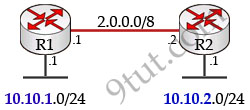
If we configure automatic summarization at classful boundaries, users on network 10.10.1.0/24 cannot communicate with users on network 10.10.2.0/24.
If you are not clear about automatic summarization please read the last part of this tutorial: http://www.9tut.com/eigrp-routing-protocol-tutorial.
Question 4
[am4show have=’p2;’]A technician pastes the configurations in the exhibit into the two new routers shown. Otherwise, the routers are configured with their default configurations. A ping from Host1 to Host2 fails, but the technician is able to ping the S0/0 interface of R2 from Host1. The configurations of the hosts have been verified as correct. What is the cause of the problem?
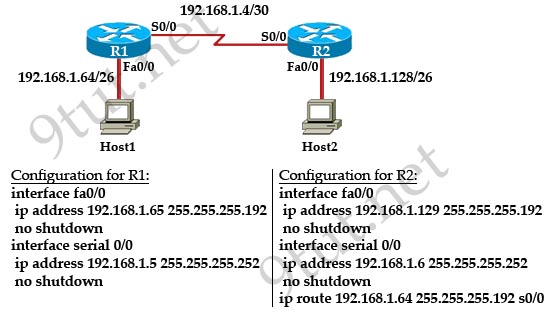
A. The serial cable on R1 needs to be replaced.
B. The interfaces on R2 are not configured properly.
C. R1 has no route to the 192.168.1.128 network.
D. The IP addressing scheme has overlapping subnetworks.
E. The ip subnet-zero command must be configured on both routers.
Answer: C[/am4show]
Explanation
Host1 can ping the Serial interface of R2 because R1 has the network of 192.168.1.4/30 as directly connected route. But R1 does not know how to route to the network of Host2 (192.168.1.128/26) so R1 will drop that ping without trying to send it out S0/0 interface. To make the ping work, we have to configure a route pointing to that network (for example: ip route 192.168.1.128 255.255.255.192 s0/0 on R1).
Question 5
[am4show have=’p2;’]Refer to the exhibit. The Lakeside Company has the internetwork in the exhibit. The Administrator would like to reduce the size of the routing table to the Central Router. Which partial routing table entry in the Central router represents a route summary that represents the LANs in Phoenix but no additional subnets?
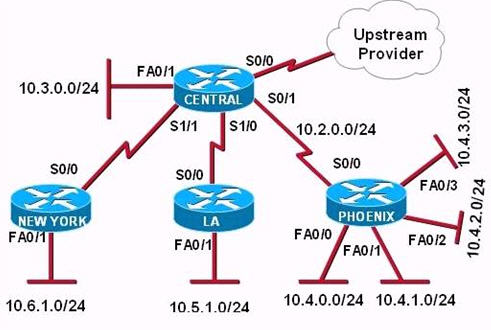
A – 10.0.0.0 /22 is subnetted, 1 subnet
D 10.0.0.0 [90/20514560] via 10.2.0.2 6w0d, serial 0/1
B – 10.0.0.0 /28 is subnetted, 1 subnet
D 10.2.0.0 [90/20514560] via 10.2.0.2 6w0d, serial 0/1
C – 10.0.0.0 /30 is subnetted, 1 subnet
D 10.2.2.0 [90/20514560] via 10.2.0.2 6w0d, serial 0/1
D – 10.0.0.0 /22 is subnetted, 1 subnet
D 10.4.0.0 [90/20514560] via 10.2.0.2 6w0d, serial 0/1
E – 10.0.0.0 /28 is subnetted, 1 subnet
D 10.4.4.0 [90/20514560] via 10.2.0.2 6w0d, serial 0/1
F – 10.0.0.0 /30 is subnetted, 1 subnet
D 10.4.4.4 [90/20514560] via 10.2.0.2 6w0d, serial 0/1
Answer: D[/am4show]
Explanation
All the above networks can be summarized to 10.0.0.0 network but the question requires to “represent the LANs in Phoenix but no additional subnets” so we must summarized to 10.4.0.0 network. The Phoenix router has 4 subnets so we need to “move left” 2 bits of “/24”-> /22 is the best choice -> D is correct.
Question 6
[am4show have=’p2;’]Refer to the exhibit. How will the router handle a packet destined for 192.0.2.156?
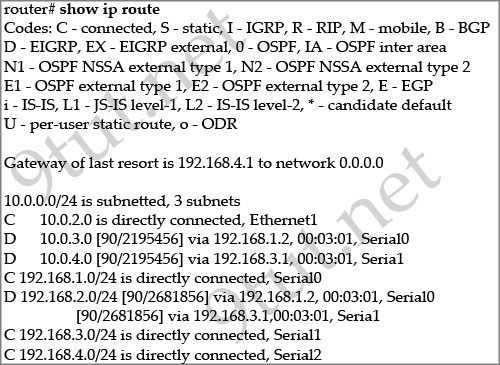
A. The router will drop the packet.
B. The router will return the packet to its source.
C. The router will forward the packet via Serial2.
D. The router will forward the packet via either Serial0 or Serial1.
Answer: C[/am4show]
Explanation
From the output we see a line “Gateway of last resort is 192.168.4.1 to network 0.0.0.0”. Gateway of last resort refers to the next-hop router of a router’s current default route. Therefore all the traffic through this router to destination networks not matching any other networks or subnets in the routing table will be sent to 192.168.4.1 (which is on Serial2) -> packet destined for 192.0.2.156 (or an unknown destination) will be forwarded via Serial2.
An weird thing in the output above is the missing of the asterisk mask (*) which represents for the candidate default route. To set the “Gateway of last resort is 192.168.4.1 to network 0.0.0.0” as the output above we can use these commands:
ip route 0.0.0.0 0.0.0.0 192.168.4.1
ip default-network 192.168.4.0
But these commands will create an static routing in the routing table with an asterisk mask. Maybe the output shown above is missing that route.
For more information about the command ip default-network please visit: http://www.cisco.com/en/US/tech/tk365/technologies_tech_note09186a0080094374.shtml.
Question 7
[am4show have=’p2;’]Refer to the exhibit. RTA is configured with a basic configuration. The link between the two routers is operational and no routing protocols are configured on either router. The line shown in the exhibit is then added to router RTA. Should interface Fa0/0 on router RTB shut down, what effect will the shutdown have on router RTA?
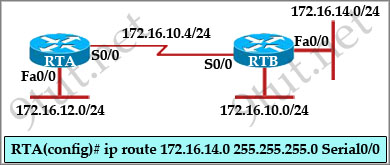
A. A route to 172.16.14.0/24 will remain in the RTA routing table.
B. A packet to host 172.16.14.225 will be dropped by router RTA
C. Router RTA will send an ICMP packet to attempt to verify the route.
D. Because router RTB will send a poison reverse packet to router RTA, RTA will remove the route.
Answer: A[/am4show]
Explanation
Static routes remain in the routing table even if the specified gateway becomes unavailable. If the specified gateway becomes unavailable, you need to remove the static route from the routing table manually. However, static routes are removed from the routing table if the specified interface goes down, and are reinstated when the interface comes back up.
Therefore the static route will only be removed from the routing table if the S0/0 interface on RTA is shutdown.
(Reference: http://www.cisco.com/en/US/docs/security/asa/asa84/configuration/guide/route_static.html)


Question 7.
The question stated that interface FA0/0 is shut down. Per the “explanation”, shouldn’t the static route then be removed from the routing table?? IF that’s the case, then Answer A is not correct.
The route is not removed because the interface Fa0/0 that is placed in shutdown state is on RTB. To remove the static route from the RTA routing table, RTA interface S0/0 should become down.
ah, yes, I see now. Thanks
This website is great. My boyfriend is studying for his ICND2 so I’m using these questions to create quiz’s for him.
Keep up the good work.
Thank you
Took ICND2 earlier today, 986 / 1000.
Questions 1, 4, 6 and 7 from this page were on there.
Can someone explain # 6 I’m not seeing that subnet in the routing table.
Routerking,
For #6, Option C is correct because that route doesn’t exist in the routing table. When you have a default route specified, a packet destined for an address outside of your specified routes will be sent to the default route. In this case, the default route says to send everything to Serial2.
Passed with 986/1000
2, 4, 6 and 7 from this page were on the test
1,2,4,6,7 were there
Passed today my ICND@2 by 1000. Got different configuration of the Eigrp & frame Relay labs where there were different DLCIs and IP addresses, but same process was used to get answers (show commands, show ip protocols, show ip interface brief ).
A question about GLBP and a question about netflow were on my test. You can find them here: http://www.examtut.com/2013/09/new-questions-in-ccna-200-120-hsrp-vrrp.html
Study 9tut and this guy i found him really helpful. He has unique way of teaching http://www.danscourses.com If you can do all his videos again and again. Trust me you will get the concept. Also one thing i learned today is if you don’t know the concept it’ll be hard for you in the exam.
All the best to every one in their path. Keep me in your good wishes.
Just passed this morning ( 973/1000).. Lots of questions from9tut at exam, thanks for the final preparation on this site, you’re nailing it down great..
you should get free dumps and many other helping materials from [ http://adf.ly/o7ba3 ]
Its a direct and safe download and the download speed is ultra high.
Also the dumps is super easy to download.
Enjoy.
Question 5
I understand why D is the correct answer but i dont understand why it is a /22. can someone please explain
Took the exam today. Pass 986/1000. Q1, Q4, Q6, Q7 were on there.
Thanks 9tut.
James, Question 5 is /22 because a Summary Static route has the mask show which bits are the same for multiple routes. Since the routes to summarize in binary end in 000, 001, 010, 011 then the only bit that remains the same for all those is the first zero in each, which is the /22 (“move left” two bits from /24).
Tested today, 8/20. #2, 3, 4, 5, 7 were on there.
passed the ICND 1 and going for the ICND 2 and so far this is the first question I am confused on. Question 5 Can someone break the whole question/answer down to dummy terms please?
Miguel,
Notice that the four “/24” subnets all share the same first 22 bits…
00001010.00000100.00000000.XXXXXXXX = 10.4.0.XXX
00001010.00000100.00000001.XXXXXXXX = 10.4.1.XXX
00001010.00000100.00000010.XXXXXXXX = 10.4.2.XXX
00001010.00000100.00000011.XXXXXXXX = 10.4.3.XXX
00001010.00000100.000000XX.XXXXXXXX = /22 for summarization…
took the exam today and pass with 907. Question 2, 3, 4 and 7 were on there, the others weren’t. location United States Florida.
test ICND 2
Thanks 9tut
Can you guys give me ideas on the ICND1 exam.. I will take the exam next week >.<
Tomorrow I’ll re-take the exam, someone knwos if there is a possibility than repeat some questions?? Or all be differents??
Regards!!!
@Andrew: How did you get on with the re-take?
Hi Guys, who will be able to help me with braindumps? everywhere I search on the internet, I have to pay and if you from South Africa, and you must multiply the amount that is in $ by 14 , it comes to a enormous amount 🙂 . Please it would be appreciated if someone can mail me a few. Thank you in advance. nallers@grintek.com
Hello friends,I’m taking my ICND2 exam tomorrow wish me luck guys..
hello Akhil, hw did ur test go? Any info can be very useful pls.. Thanks in advance.
passed on 3/13. questions 1 and 4 on there. tks 9tut
This website is great, explanations are on point and interesting. Well done 9tut.
I got Q2, Q3, Q4, Q7 today in my ICND2 exam.
Thanks 9tut.
misread the question – sorry – it says Should interface Fa0/0 on router RTB shut down, what effect will the shutdown
and I agree with the answer
Got Q7.
get dumps with nuggets free from this following link
wurl. cc/dumps
Just took the test today – 980/1000 Q4 came from this page. Thanks 9tuts! Also got Frame Relay, EIGRP and OSPF labs
THERE IS NO NEED FOR ANY DUMPS – just study one book (Wendel or Todd) and the you tube lessons available free for visual knowledge. Along with 9tuts these are enough for 900 and over marks with ease.
But you MUST understand the concepts and not mug up the answer as they change the options and answers
@all: We had to move all the questions and answers out of 9tut. We can only keep the explanation. You can download the questions and answers at: https://mega.co.nz/#!oIdESYbD!yyu33vygrfKPy4rcmcbV6qW2fxINNoTokuDM3CjA_og
Hey 9tut. Why do you have us install a program for the questions and answers? I’m hesitant about malware
@anon: You don’t need to install any program. Please download the file in this link instead: http://www.mediafire.com/view/686kvdms48m67k7/ICND1_2_Questions_July_2015.pdf
Would someone please explain q3 regarding Automatic summarization at classful boundaries. I thought only auto -summary involves classless.
Thanks in adv.
I GOT Q 2,3,4,7 TODAY
hie guys i taking my icnd2 exam on wed can anyone give me links of recent questions
thankyu in advance